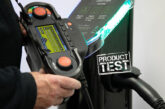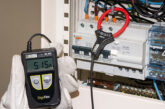
We gave the MFT 1711 to our Product Tester, Kelly Vincent, to see if it made the difference.
For the last six years I have been using my trusty Megger MFT 1552. It has never let me down, so it would take a very impressive product indeed to convince me to upgrade. Megger claims that this latest series comes with loads of new features, but how different can they really be?
Megger is advertising this tester as being tougher than its predecessor, and you only need to inspect the latest model for a few minutes to see why. The 1711 is IP54 and has been designed to be used in any environment. Its dust and rain proof and a real solid piece of equipment, brilliant for taking outside on a rainy UK summer day for fault finding in the garden. Saying that, it’s not heavy in the slightest (in fact it’s lighter by 44g than the 1552). I had the strap attached for a good two hours around my neck whilst performing R1R2 tests and even my slight build could handle it!
It comes with a quick start guide and a full user guide on CD, both of which I read thoroughly wanting to get the most out of the 1711. It was a comprehensive guide and I had the Megger up and running doing practice runs in my house (whilst annoying my family) in no time. It’s easy to use, the settings are straight forward and the rotary dials sit firmly in place. The calibration certificate sits neatly inside the carry case pocket alongside my labels, there’s even enough space for a notepad and a few small tools that I can keep with it so I can just grab and go when I need to get the job done. The leads are GS38 compliant with thick but flexible red blue and green leads, interchangeable probes and croc clips and a main plug test lead. The connection of the leads to the device was solid and I was confident they weren’t going to pop out mid-test like my old non-branded leads used to.
“The RCD testing was super fast and saved me loads of time not standing around waiting at the RCD. It has a two- and three-wire non-trip test capability which is great for when you need to take a loop impedance test at a light switch with no neutral.”
Key features
During installation testing, the lock button allows you to lock in the test button so you no longer have to hold it down until it has reached its maximum reading which I found really useful, and it gave my thumb a bit of break! The insulation resistance test voltages now come as 250v, 500v and 1kV.
The Max Z display is one of favourite features, no more memorising or scribbling down readings whilst trying to count number of points, the Megger did the work for me and displays the highest Zs reading above each individual Zs reading. It’s the little things that make us happy!
The RCD testing was super fast and saved me loads of time not standing around waiting at the RCD. It has a two- and three-wire non-trip test capability which is great for when you need to take a loop impedance test at a light switch with no neutral. The prospective fault current or prospective short circuit current measurement is automatically performed at the same time as loop resistance testing, so it combines two tests into one, saving me even more time on the job.
All these little time saving things really did add up, on  days where we’re doing EICRs on different properties in a day it meant we were able to do the same job as we have been doing for the last six years more efficiently, and be able to get home at a decent hour for once!
days where we’re doing EICRs on different properties in a day it meant we were able to do the same job as we have been doing for the last six years more efficiently, and be able to get home at a decent hour for once!
The display screen is large and backlit for use in low light condition, the results are large enough to see clearly at a quick glance or in poor visibility and the digital arc makes fluctuating readings easy to spot.
Safety first
The product is promoted as having a really high degree of safety, so I put it to the test. It feels almost idiot proof, I connected the leads between line and neutral on a live circuit to do an insulation resistance test and there was a clear warning sound and the display flashed to let me know there was voltage. Even when I pressed the test button it blocked the test. It really is protected against accidental misuse which is just what you need when training new staff who are still getting to grips with testing.
MFT 1721 includes three-phase testing and current measurement. In addition, the MFT 1731 features Bluetooth connectivity so you can download date from its on-board memory. I can imagine the Bluetooth downloading and on board memory being a really professional addition to the job saving us hours of inputting data when we should be spending time relaxing and spending time with our families after work.








